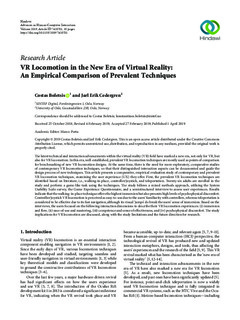| dc.description.abstract | The latest technical and interaction advancements within the virtual reality (VR) field have marked a new era, not only for VR, but also for VR locomotion. In this era, well-established, prevalent VR locomotion techniques are mostly used as points of comparison for benchmarking of new VR locomotion designs. At the same time, there is the need for more exploratory, comparative studies of contemporary VR locomotion techniques, so that their distinguished interaction aspects can be documented and guide the design process of new techniques. This article presents a comparative, empirical evaluation study of contemporary and prevalent VR locomotion techniques, examining the user experience (UX) they offer. First, the prevalent VR locomotion techniques are identified based on literature, i.e., walking-in-place, controller/joystick, and teleportation. Twenty-six adults are enrolled in the study and perform a game-like task using the techniques. The study follows a mixed methods approach, utilising the System Usability Scale survey, the Game Experience Questionnaire, and a semistructured interview to assess user experiences. Results indicate that the walking-in-place technique offers the highest immersion but also presents high levels of psychophysical discomfort. Controller/joystick VR locomotion is perceived as easy-to-use due to the users’ familiarity with controllers, whereas teleportation is considered to be effective due to its fast navigation, although its visual ‘jumps’ do break the users’ sense of immersion. Based on the interviews, the users focused on the following interaction dimensions to describe their VR locomotion experiences: (i) immersion and flow, (ii) ease-of-use and mastering, (iii) competence and sense of effectiveness, and (iv) psychophysical discomfort. The study implications for VR locomotion are discussed, along with the study limitations and the future direction for research. | nb_NO |

